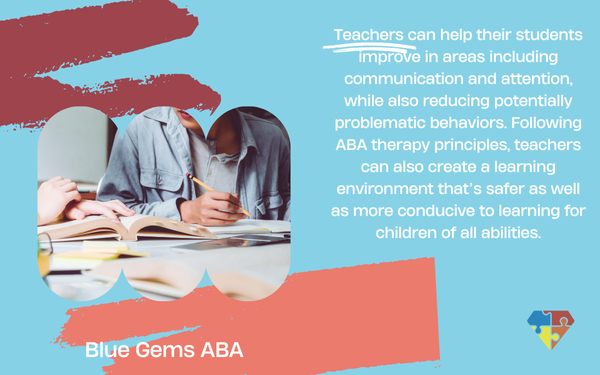Why Would Teachers Benefit from ABA Training?
Applied behavior analysis, or ABA therapy, is widely regarded as the leading treatment option for children with autism spectrum disorder (ASD). As a science-based approach to learning and behavior, ABA therapy can prove very effective at helping children with autism build the social and communication skills with which they typically struggle.
While ABA therapy is used most commonly for children on the autism spectrum, it has many applicable uses for children with other developmental disabilities such as ADHD and even for typically-developing children.
Teachers are usually not specialists in ABA therapy, though they do obviously play a key role in the overall support of all children, regardless of their developmental abilities.
As such, teachers can benefit immensely from receiving ABA training. In this article, we’ll describe just some of those benefits.
Table Of Contents
What Role Do Teachers Play in ABA Therapy?
Teachers play an integral role in the development of all children. For children with ASD, teachers are an essential cog in ABA therapy.
For ABA therapy to be as successful as possible, all the caregivers and professionals who support the child need to be involved. If the child is in a typical school environment, then, this group includes teachers.
Not only can teachers help to support children with autism by using similar ABA therapy strategies and tools that are used by BCBAs, they can also help support the child’s treatment plan by collecting data that can inform their support.
Teachers can collaborate directly with the child’s ABA therapist to establish goals as well as design interventions to best help support the child’s unique strengths, challenges and preferences.
By receiving ABA therapy training, teachers can ensure that they understand the basis behind the strategies, how to implement them in the classroom setting and how to better communicate with therapists to ensure the highest-quality support possible.
How Can Teachers Benefit from ABA Training?
Even if teachers don’t have children with autism in their classroom, they can still benefit immensely from ABA training.
Since ABA therapy enhances communication and social skills as well as academic performance, its principles can be followed to enhance academic performance across the board for all students.
Teachers can help their students improve in areas including communication and attention, while also reducing potentially problematic behaviors. Following ABA therapy principles, teachers can also create a learning environment that’s safer as well as more conducive to learning for children of all abilities.

Training programs can be set up to educate teachers on the specific strategies and tools that they can use in the classroom to promote learning and understanding. The strategies are designed in a way to create a classroom environment that is both supportive and structured, one that promotes independence and enhances engagement among all students.
ABA therapy can, in essence, facilitate the most positive outcomes possible not just for students with autism but for all students.
What Specific ABA Therapy Strategies Can Teachers Use in the Classroom?
It takes many years of education, training and experience to master the strategies and techniques of ABA therapy. At the same time, there are many strategies that can be taught in a way that teachers can apply to their classroom.
Some of these strategies include …
- Positive reinforcement: A key component of ABA therapy, positive reinforcement rewards children for exhibiting certain behaviors, which then encourages ongoing engagement and learning.
- Simplification: Children with autism learn better when complicated tasks are broken down into simpler steps. Teachers can follow this strategy to teach new skills and concepts to all students, making it more manageable for them to grasp.
- Prompting: ABA therapists use prompting to provide a clue to children that it’s time to do something, and teachers can follow this strategy in the classroom, too.
- Collecting Data: A large part of ABA therapy is collecting and analyzing data to evaluate progress toward goals. Teachers can do this in the classroom to effectively assess what’s working and what’s not for each individual student.
| Role in ABA | Practical Classroom Strategy | Outcome for Students |
|---|---|---|
| Collaborator | Collect data for therapy coordination | Personalized support |
| Reinforcer | Use positive reinforcement | Increased motivation |
| Simplifier | Break down complex tasks | Easier skill acquisition |
| Prompter | Provide cues for expected behavior | Improved compliance |
| Observer | Monitor and assess behavior trends | Tailored interventions |
Blue Gems ABA Works with Teachers to Fully Support Children with ASD
Teachers can benefit in numerous ways by receiving ABA training. Even if they are working directly with children who have ASD, following some of the principles and strategies of ABA therapy can result in better outcomes for all students.
At Blue Gems ABA, we work directly with parents, caregivers, teachers and other professionals to ensure a collaborative effort to fully support the children with autism who we serve. This helps us produce better outcomes for all our patients.
To learn more, please contact us today.




